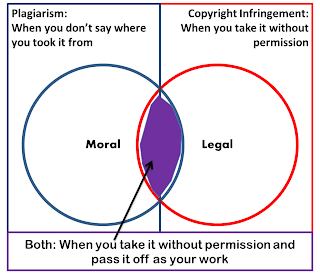
Open Access - Open Access is "the immediate, online, free availability of research outputs without the severe restrictions on use commonly imposed by publisher copyright agreements," according to the Open Access Scholarly Information Sourcebook. Open Access images are images tmages that archives, libraries, museums, or copyright holders have chosen to make available online without restrictions on distribution or reuse. The author does retain integrity over the work and the right to be cited properly.

Image from Wikipedia published under Creative Commons License
Copyright is the legal right of creators to control how their works are used by others. Copyright protects works such as poetry, movies, CD-ROMs, video games, videos, plays, paintings, sheet music, recorded music performances, novels, software code, sculptures, photographs, choreography and architectural designs. The Copyright Term refers to the period of time a work is covered by copyright.
For more information on copyright, see the following:
Fair Use - A provision in copyright law that allows for the use of copyrighted works under some specific circumstances and for particular purposes such as criticism, comment, scholarship, or research. Fair use is determined by the following four factors (from Chapter 1, Section 107 of the Copyright Law):
To help you determine if your use is a "fair use," consult one of the fair-use checklists
Public Domain - A work is in the public domain when it is no longer covered by copyright, because the copyright term has expired, the creator has released the work, or the work was never copyrighted. The public then holds the rights to the work and can make use of the image. This means that you can use as much of the work as you would like to support your instruction, research, publication, creative work, etc. without needing permission from the original copyright owner.
Determining if a work is in public domain can be tricky. Consult the following charts for guidance:

Creative Commons - a nonprofit organization that works "to increase the amount of creativity (cultural, educational, and scientific content) in “the commons” — the body of work that is available to the public for free and legal sharing, use, repurposing, and remixing." (http://creativecommons.org/about/what-is-cc).
Creative Commons licenses provide a way for people to share their work and make it available for others to build on and reuse. It is free to download, adapt, distribute, and transmit without having to ask permission. Depending on the license, however, there may be certain conditions: you may only be able to use the content for educational purposes, you may have to give attribution, etc. Because licenses vary, always be sure to check the exact terms of the license before using an image.
 Attribution: others can use the work however they like, so long as they give credit
Attribution: others can use the work however they like, so long as they give credit
 No Derivative Work: other can copy, display, or perform your work, but it must be verbatim
No Derivative Work: other can copy, display, or perform your work, but it must be verbatim
 Non-Commercial: other can use your work, but for non-commercial purposes only
Non-Commercial: other can use your work, but for non-commercial purposes only
 Share Alike: others can distribute derivative works, but only under the same terms as the original license
Share Alike: others can distribute derivative works, but only under the same terms as the original license
Check out the Creative Commons website for more information and details about CC licenses.





